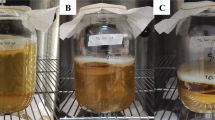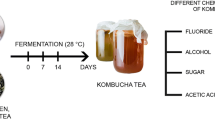Abstract
The aim of the present study was to determine the chemical composition (organic acids—acetic, tartaric, citric; sugars—sucrose, glucose, fructose; total acidity, alcohol content, pH—with FTIR instrument; content of selected mineral compounds—AAS instrument), antioxidant activity, antimicrobial activity and sensory profiles of prepared kombucha tea beverage. Black tea with white sugar as a substrate for kombucha beverage was used as a control sample. The dominant organic acid in kombucha tea beverage was acetic acid (1.55 g/L), followed by tartaric and citric acids. The sucrose (17.81 g/L) was the dominant sugar from detected sugars. Antioxidant activity of beverage tested by reducing power method (1318.56 mg TEAC/L) was significantly higher (p < 0.05) in comparison with black tea (345.59 mg TEAC/L). The same tendency was observed for total polyphenol content which was significantly higher (p < 0.05) in kombucha beverage (412.25 mg GAE/L) than in black tea (180.17 mg GAE/L). Among mineral compounds, the amount of manganese (1.57 mg/L) and zinc (0.53 mg/L) was the highest in kombucha tea beverage. Results of antimicrobial activity of kombucha tea beverage showed strong inhibition of Candida krusei CCM 8271 (15.81 mm), C. glabrata CCM 8270 (16 mm), C. albicans CCM 8186 (12 mm), C. tropicalis CCM 8223 (14 mm), Haemophilus influenzae CCM 4454 (10 mm) and Escherichia coli CCM 3954 (4 mm). Sensory properties of prepared beverage were evaluated overall as good with the best score in a taste (pleasant fruity-sour taste). The consumption of kombucha tea beverage as a part of drinking mode of consumers due to health benefits is recommended.

Similar content being viewed by others
References
Agency for Toxic Substances and Disease Registry (2007) Public health statement lead. U.S. Departament of Health and Human Services, Public Health Service. Retrieved June 11, 2017, from https://www.atsdr.cdc.gov/ToxProfiles/tp13-c1-b.pdf
Aidoo E (2015) Studies on the cytotoxicity and antioxidant activity of tea kombucha. Dissertation work, University of Ghana. 2015. 65 pp
Amarasinghe H, Weerakkody NS, Waisundaza VY (2018) Evaluation of physicochemical properties and antioxidant activities of kombucha “tea fungus”. Food Sci Nutr 6:659–665
Battikh H, Chaieb K, Bakhrouf A, Ammar E (2013) Antibacterial and antifungal activities of black and green kombucha teas. J Food Biochem 37:231–236
Bauer-Petrovska B, Petrushevska-Tori L (2000) Mineral and water soluble vitamin content in the kombucha drink. Int J Food Sci Technol 36:201–205
Chen C, Liu BY (2000) Changes in major components of tea fungus metabolites during prolonged fermentation. J Appl Microbiol 89:834–839
Essawet NA, Cvetkovic D, Velicanski A, Čanadanovič-Brunet J, Vulic J, Maksimovic V, Markov S (2015) Polyphenols and antioxidant activities of kombucha beverage enriched with coffeeberry extract. Chem Ind Chem Eng Q 21:399–409
Filippis F, Troise AD, Vitaglione P, Ercolini D (2018) Different temperatures select distinctive acetic acid bacteria species and promotes organic acids production during kombucha tea fermentation. Food Microbiol 73:11–16
Fu C, Yan F, Cao Z, Xie F, Lin J (2017) Antioxidant activities of kombucha prepared from three different substrates and changes in content of prebiotics during storage. Food Sci Technol 34:123–126
Jayabalan R, Marimuthu S, Swaminathan K (2007) Changes in content of organics acids and tea polyphenols during Kombucha tea fermentation. Food Chem 102:392–398
Jayabalan R, Malbaša RV, Lončar ES, Vitas J, Sathishkumar M (2014) A review on Kombucha tea—microbiology, composition, fermentation, beneficial effects, toxicity, and tea fungus. Compr Rev Food Sci Food Saf 13:538–550
Leal JM, Suaréz LV, Jayabalan R, Oros JH, Escalante-Aburto A (2018) A review on health benefits of kombucha nutritional compounds and metabolites. CYTA: J Food 16:390–399
Mamisahebei S, Khaniki GRJ, Torabian A, Nasseri S, Naddafi K (2007) Removal of arsenic from an aqueous solution by pretreated waste tea fungal biomass. Iran J Environ Health Sci Eng 4:85–92
Neffe-Skocińska K, Sionek B, Šcibiszi I, Kolozyn-Krajewska D (2017) Acid contents and the effect of fermentation condition of kombucha tea beverage on physicochemical, microbiological and sensory properties. CYTA: J Food 15:601–607
Oyaizu M (1986) Studies on products of browning reaction-antioxidative activities of products of browning reaction prepared from glucosamine. Jpn J Nutr 44:307–314
Prado FC, Parada J, Pandey A, Soccol CR (2008) Trends in non-dairy probiotic beverages. Food Res Int 4:111–112
Pure AE, Pure ME (2016) Antioxidant and antibacterial activity of kombucha beverages prepared using banana peel, common nettles and black tea infusions. Appl Food Biotechnol 3:125–130
Reva ON, Zaets IE, Ovcharenko LP, Kukharenko OE, Shpylova SP, Podolich OV, Vera JP, Kozyrousa NO (2015) Metabarcoding of the kombucha microbial community grown in different microenvironments. AMB Express 5:2–8
SAS (2009) Users guide version 9.2 SAS/STAT (r). SAS Institute Inc., Cary
Singleton VL, Rossi JA (1965) Colorimetry of total phenolics with phosphomolybdic-phosphotungstic acid reagents. Am J Enol Vitic 6:144–158
Spedding G (2015) So what is kombucha? An alcoholic or a non-alcoholic beverage? A brief selected literature review and personal reflection. BDAS, LLC http://alcbevtesting.com/wpcontent/uploads/2015/06/WhatIsKombucha_BDASLLC_WPSPNo2_Oct-4-2015.pdf
Tu YY, Xia HL (2018) Antimicrobial activity of fermented green tea liquid. Int J Tea Sci 6:29–35
Veličanski A, Cvetkovič D, Markov SL, Šaponjac VTT, Vulič JJ (2014) Antioxidant and antibacterial activity of the beverage obtained by fermentation of sweetened lemon balm (Melissa officinalis L.) tea with symbiotic consortium of bacteria and yeast. Food Technol Biotechnol 52:420–429
Villarreal-Soto SA, Beaufort S, Bouajila J, Souchard JP, Taillandier P (2018) Understanding kombucha tea fermentation. A review. J Food Sci 83:580–588
Vitas JS, Cvetanovic AD, Maškovič PZ, Švarc-Gajič JV, Malbaša RV (2018) Chemical composition and biological activity of novel types kombucha beverages with yarrow. J Funct Foods 44:95–102
Watawana MI, Jayawardena N, Gunawardhana CB, Waisundara VY (2015) Health, wellness, and safety aspects of the consumption of kombucha. J Chem, 1–11
Ye M, Yue T, Yuan Y (2014) Evaluation of polyphenols and organic acids during the fermentation of apple cider. J Food Agric 94:2954–2957
Yuniarto A, Anggadiredja K, Aqidah RAN (2016) Antifungal activity of kombucha tea against human pathogenic fungi. J Pharm Clin Res 9:253–255
Acknowledgements
This work was co-funded by the European Community project no 26220220180: Building the Research Centre “AgroBioTech” (50%) and VEGA 1/0411/17 (50%).
Author information
Authors and Affiliations
Corresponding author
Ethics declarations
Conflict of interest
All authors declare no conflict of interest.
Additional information
Publisher's Note
Springer Nature remains neutral with regard to jurisdictional claims in published maps and institutional affiliations.
Rights and permissions
About this article
Cite this article
Ivanišová, E., Meňhartová, K., Terentjeva, M. et al. The evaluation of chemical, antioxidant, antimicrobial and sensory properties of kombucha tea beverage. J Food Sci Technol 57, 1840–1846 (2020). https://doi.org/10.1007/s13197-019-04217-3
Revised:
Accepted:
Published:
Issue Date:
DOI: https://doi.org/10.1007/s13197-019-04217-3




